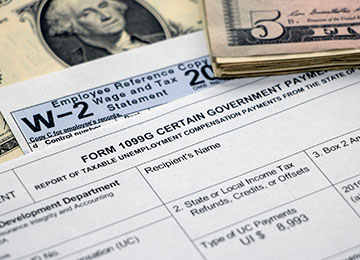Pandemic Drives Record Unemployment TEXAS WORKFORCE COMMISSION FLOODED WITH CLAIMS
Businesses across Texas and the nation have been forced to curtail or cease operations in the face of the coronavirus pandemic, throwing millions out of work and prompting a record increase in unemployment claims that is straining the safety net for workers.

The Texas Workforce Commission (TWC), like its counterparts across the U.S., initially struggled to cope with the flood of out-of-work people trying to file claims.
An Unprecedented Challenge
Nearly 2 million people in Texas filed for unemployment insurance benefits from the week ending March 14 through May 9, nearly triple the number of claims filed in all of 2019.
A record 315,167 Texans filed initial jobless claims during the week ending April 4; a comparable week in 2019 saw about 13,000 claims. Texas’ weekly claims during the Great Recession of 2007-09 peaked at 49,398.
Many more people, however, tried to contact TWC online or by phone; the agency received 2.7 million calls from 153,000 unique callers on April 22 alone.
In response, TWC rushed to ramp up its web-based and telephone systems, boost staffing and extend operating hours to ensure claimants could get the benefits due them.
“It’s happening all over the country — the agencies that deal with unemployment claims are just overwhelmed,” says economist Bernard Weinstein, associate director of Southern Methodist University’s Maguire Energy Institute. “We’ve never seen anything like this.”
In energy-intensive Texas, the impact was compounded when oil prices plummeted and demand fell. According to Weinstein, the Texas unemployment rate could reach 15 percent in the next several months — up from 12.8 percent in April — but he foresees the recovery process beginning this summer. And while the economic shock may be stressing the state’s unemployment insurance system, he has no doubt it will withstand the pressure.
“I think we can be confident that the services will be there,” Weinstein says.
State Response
James Bernsen, TWC’s deputy communications director, says the agency has prepared for emergency situations, “but no one could have anticipated the unprecedented nature of this crisis.”
TWC upgraded its web and phone capacity, adding more computer servers and doubling the number of call centers. It also expanded call center hours to 12 hours a day, from 7 a.m. to 7 p.m., seven days a week.
The agency tapped employees from other divisions to help with claims and hired temporary workers. The Legislature even sent staffers to assist. In early March, about a thousand people were fielding claims; by early April, there were 1,546, according to TWC.
Among its other actions, TWC temporarily waived work search requirements and the one-week waiting period for unemployment benefits. It also allowed children to remain eligible for subsidized childcare even if their parents’ jobs, schooling or training were lost or interrupted, and/or if parents were unable to pay their share of the cost, through June 1. The agency also is promoting its Shared Work Program to companies as an alternative to layoffs, by making unemployment benefits available to workers whose regular hours are reduced.
The state’s Unemployment Compensation Trust Fund had a closing balance of about $933 million on May 21, according to TWC. Bernsen said the agency has been authorized to draw federal advances of up to $2.6 billion in June and $2 billion in July. These federal dollars would come from Title XII of the Social Security Act, which can provide loans without interest through December.

Federal Response
In response to the crisis, the federal Coronavirus Aid, Relief, and Economic Security (CARES) Act was signed into law on March 27. The CARES Act expands unemployment insurance eligibility to those who normally wouldn’t qualify, such as contract workers and self-employed individuals. It also funds up to 13 weeks of additional unemployment benefits until Dec. 31, 2020, on top of the usual 26 weeks offered by the state of Texas.
In addition, the law will fund additional federal benefits of $600 a week for up to four months until July 31. Texas’ maximum weekly state benefit, excluding this additional federal amount, is $521 in 2020.
Slow Recovery to Come?
Weinstein expects the eventual economic recovery will be slow.
“It could actually be a couple of years before the economy is back to full health,” he says. “And that’s going to depend in part on what happens to the rest of the world.”
Ed Serna, TWC executive director, said in an April 8 Facebook Live briefing that the agency would sustain what is expected to be a lengthy effort to meet the public’s needs.
“It’s really just us helping our neighbors and our fellow Texans,” Serna said. “We ask you to continue to work with us. Continue to be patient with us. As much as possible, we are going to continue to improve how we provide you [with] resources … and to help you as much as we can.” FN
Visit the Texas Workforce Commission.

